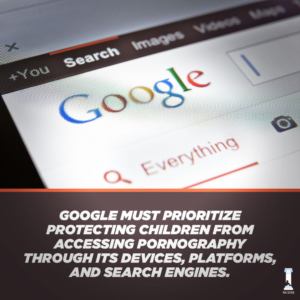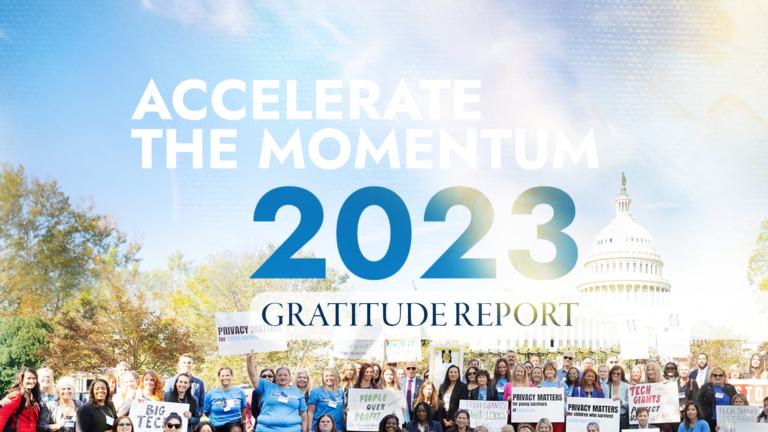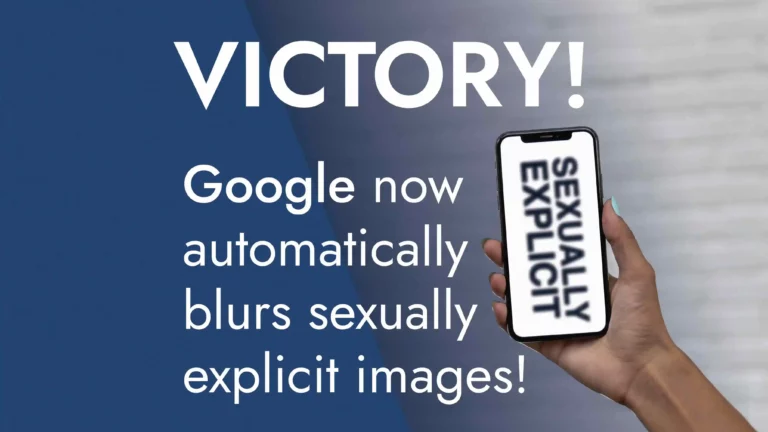This blog was edited on 10/30/20 in the section about EBSCO for further clarity after receiving a request to do so from EBSCO’s legal counsel. Please see the letter from EBSCO and our response on our webpage about EBSCO here.
Corporations and brands shape culture, and unfortunately, their influence has permeated into our education system. Due to the steadily growing reliance on technology in schools—exponentially increased during the pandemic—already powerful companies are influencing and even determining the content our kids are consuming, shaping their young minds. Two corporate giants that dominate EdTech include Google and EBSCO. While these companies offer many benefits, such as increased access to information and communication, their “services” come with risks. Both Google and EBSCO have been on the National Center on Sexual Exploitation’s Dirty Dozen List multiple years in a row for failing to protect children and for profiting from sexual exploitation. These two corporations possess the money and manpower to significantly and proactively safeguard children using their products. Instead, they pander to or normalize the porn industry [edited for clarity] and put the onus on overburdened schools and families to make their products safer.
Google has built a global empire that has significant reach into our schools. According to Google’s 2019 figures, 80 million educators and students worldwide are using G Suite for Education, with 30 million using Chromebooks in the classroom. Prior to the pandemic Chromebooks made up about 60% of tech devices used in US schools, with the numbers being purchased this year growing significantly as countless school districts and families bought and continue to buy Chromebooks for distance learning. As one of the most important tech companies in the world—one that is profiting from and greatly influencing the education sector—Google must prioritize protecting children from accessing pornography through its devices, platforms, and search engines.

Google was named to NCOSE’s 2020 Dirty Dozen List for several reasons, including failing to proactively address students’ easy access to pornography through Chromebooks. We’re pleased that Google has made some recent improvements (the ability to add a Google Classroom school account to Family Link through Chromebooks and changing algorithms to reduce the amount of hardcore pornography displayed when searching innocent, unrelated terms like “happy black teens”). However, searches more closely tied to or directly related to sex or pornography will yield hardcore pornographic results within seconds.
Students using school-distributed Chromebooks are at risk of being exposed to pornography, all because Google refuses to proactively turn on parental controls on the devices it knows are being sold to schools—and most Chromebooks produced are being sold to schools. Given that Chromebooks are most often being used by students, it would be logical for the multi-billion dollar company to turn-on filtering tools for all Chromebooks. But instead it has placed the burden on schools and families. Though Google does provide measures for schools to filter and block certain content on Chromebooks, IT administrators are often confused by the many steps required to turn on and consistently monitor them. During the pandemic, ensuring adequate filtering systems for distance learning are incredibly complicated and often beyond the capacity of school IT administrators and families to figure out on their own.
.@Google, why do you refuse to proactively turn on parental controls to #ProtectChildrenOnline? Click To Tweet
At a minimum, all Google devices sold to schools should by default have SafeSearch turned on. SafeSearch helps block explicit images, videos, and websites from Google Search results. SafeSearch is a pretty good filter that seems to block almost everything that is pornographic. We’ve urged Google to make SafeSearch settings more easily accessible and we were pleased that they recently placed the “Safe Search” button in a more prominent location on Google Images (but not on other search tabs). However, this button only shows up once a search term is entered, potentially filling the screen with graphic images.
When I received our three oldest children’s Chromebooks (two provided by the school, one that we purchased ourselves), it took me nearly 4 hours to find the necessary resources, read them over, understand them enough to turn on the controls and filters, figure out what if anything the school did to safeguard them (since parents didn’t receive any information), and test them to ensure they were as porn-proof as possible. And I’m still not 100% sure I did everything correctly. That was just for my Kindergartener’s device.
As a public school parent and a taxpayer whose money is going to Google contracts, I plead with Google to set SafeSearch as the default setting for all users, but especially for K–12 students. Let porn-users spend hours struggling through the multiple steps to try to access inherently degrading, racist, damaging material you currently make so readily available. Instead, you could support overburdened schools and overwhelmed, anxious parents by turning on filtering tools and settings so we could spend our time focused on the kids, not on complicated controls.
“Do the right thing” Google: Protect kids instead of pandering to porn-users.
Do the right thing @Google: Protect kids instead of pandering to porn users. Click To Tweet
Actions
- This clearly-outlined blog by digital safety experts at Protect Young Eyes, walks parents, guardians, and teachers through the steps of safeguarding both personal and school-issued Chromebooks.
- Sign this petition asking Google to proactively filter Chromebooks
EBSCO
I’m an involved parent in my children’s public school and I do my best to stay on top of all the learning tools they’re using. Which is why I was so taken aback that in the six years I’ve had kids in school, neither I nor any of the other parents I asked had ever heard of EBSCO or its competitor, Gale. And we certainly didn’t know that the widely-used EBSCO products geared toward K – 12 students (including in our school district and state) consistently contain extremely graphic sexual content, direct links to hardcore porn and prostitution sites, written pornography (what people call ‘erotic adult literature’) and even content that in effect advertises and promotes sex toys and commercial sex [edited for clarity 10/30/20].
EBSCO is the leading provider of research databases, e-journals, magazine subscriptions, e-books and other services to libraries of all kinds, including to public and private K-12 schools. It’s extremely popular worldwide and found in schools throughout the US. States, school districts, and sometimes individual schools purchase research databases like EBSCO and Gale for students as “safer” alternatives to using the Internet. In fact, these databases can bypass Internet filters in some schools or districts, so graphic material on the site is not blocked. Live links and web addresses to hardcore pornography sites like Pornhub (which is known to be rife with videos of actual rape, sex trafficking, and child sex abuse, as well as videos glorifying violence against women, racism, and incest) and prostitution websites (like Seeking Arrangements ) are found in many of the databases. While some school Internet filters may block access if a minor clicks on the live links or tries to access the sites outside of the databases, not all do. And with children easily accessing the databases at home – even more so during virtual schooling – inadequate filters at home can potentially lead a minor to a bondage website within 30 seconds of searching the term “spanking ” [edited for clarity]. EBSCO boasts “high-quality, age-appropriate” content that “correlates to curriculum standards.” Material placed on EBSCO databases is curated, meaning selected by EBSCO employees and sophisticated software. So this corporation and others like it are literally determining your kids’ educational content – and apparently, that includes sexually graphic material and even pornography.
In 2020, a middle school search in Minnesota for “city dwellers” brings up language detailing violent acts against women and links to a porn site where videos depicting incest, extreme violence, group sex, child sexual abuse material, non-consensual sex, and more are featured throughout the site. [edited for clarity]. On a Virginia middle school’s EBSCO Explora database, searching “fashion photography” leads to an article “SEX, SNUFF + SADISM” containing extremely graphic photos portraying sexualized bodies as corpses [screenshots of these examples can be found here, as requested by EBSCO], and easily linking to other pornographic images, including what looks like penetration, and graphic cartoons [edited for clarity]. And high school students in Arizona see promotional material for a book titled “Anything for a Dollar” on EBSCO’s Novelist with easily-accessible excerpts containing extremely graphic language [edited for clarity]. Examples like this abound in schools across the United States. Research teams have found evidence in Canada and across the U.S. in the 4 years since these concerns first came to light [edited for clarity].
How is it that an educational product meant for minors contains sexually explicit material, and material promoting commercial sex? Profit.
In addition to EBSCO receiving your tax or tuition dollars when states or schools purchase their products, EBSCO also is paid by publishers who want “to increase accessibility of their” content on the databases [edited for clarity]. EBSCO’s marketing material promises to deliver increased visibility, improved brand recognition, additional website traffic and increased sales, and invites prospective clients to “let EBSCO be your global sales partner. We can help expand the reach of your content or service, increase penetration in existing and new markets.” And those “markets” include your child. Given what is “curated” by EBSCO on these sites, EBSCO allows news and articles normalizing, glamorizing, and linking to the commercial sexual exploitation industry into its products for minors and thereby must be held accountable for grooming impressionable youth to accept such messages [edited for clarity].
EBSCO has been on NCOSE’s Dirty Dozen List in past years and remains on our 2020 “Watchlist.” We must acknowledge that EBSCO has made progress when we and allies pressured them, particularly in databases meant for elementary and middle school students. Just two years ago basic searches for innocent search terms like “7th grade biology” or “respiration” would yield results with pornographic images or explicit instructions on risky sex acts. Now, searches for even pornographic terms often yield no result in these databases. There have also been some improvements in the high school databases, although NCOSE researchers still find non-academic, salacious, and sexually graphic content, including sexually graphic written descriptions and instructions for oral sex and other sexual acts. But those improvements are not enough, as subscribers to K-12 EBSCO databases still have access to sexually explicit content—particularly because in many schools and states, child subscribers to younger databases are able to easily “hop” into databases for older students [edited for clarity]. The continued inclusion of such explicit material in a platform meant for children and teens sends a particularly damaging message to young people that the behavior featured (group or hook-up sex, anal sex, incest, “sugar dating,” prostituting to pay for college, etc) is normal and expected adult behavior.
One of EBSCO’s excuses for inaction is asserting that schools and library administrators should be responsible for removing inappropriate content, yet EBSCO doesn’t adequately warn administrators that the content is so easily available on its systems. Until EBSCO takes further action to clean up the content, school boards, administrators, teachers, and parents need to be aware of these problematic databases and consider turning them off until they’re scrubbed.
So what can be done to change this? Fortunately, educators and parents across the US are paying closer attention and calling out EBSCO, Gale, and other research database companies for leaving in harmful material that could even be benefitting the sex industry [edited for clarity]. Activists in several states are pressuring lawmakers to set basic standards for these databases, ensure adherence to existing laws protecting children, and to close loopholes that allow these databases to bypass Internet filters: Idaho recently passed such a law and other states have legislation introduced or drafted [edited for clarity]. Others are taking legal action, suing EBSCO for knowingly including sexually explicit and obscene material to children. And of course, concerned parents and taxpayers are pressuring their school districts, schools, and EBSCO directly—and we invite you to do the same!
.@EBSCO: Clear your conscience by cleaning the content on your K–12 databases. Click To Tweet
Actions
- Send this letter to school boards, administrators, and PTA urging them to examine the databases they are using, report findings to parents, and—if necessary—turn off the databases until they are cleaned.
- See for yourself what EBSCO and Gale databases believe is age-appropriate material on our EBSCO Watchlist page and Pornography is Not Education, a leading organization holding these databases accountable
- Email EBSCO executives with one click, demanding they remove pornographic, sexually explicit content including live links and web addresses to pornography and prostitution sites in K-12 databases [edited for clarity]
Learning environments for students should be safe and healthy, and that means a porn-free environment. Now more than ever we need leadership from corporations in prioritizing the social, emotional, and physical well-being of children. The burden cannot rest on schools and families alone. Given how many children are using these platforms at an ever-increasing rate, stronger protections against potential harm from pornography on school-distributed devices, databases, and learning platforms must be implemented by Google, EBSCO, and all EdTech corporations immediately, not incrementally.
*The National Center on Sexual Exploitation’s 2020 Back to School(ing) Campaign aims to equip families and educators with information, resources, and actions they can take to keep kids safe online as vast numbers of students start the school year in a virtual learning environment. Over the four week campaign, we’ll feature the people, organizations, and entities that can have the greatest impact ensuring a safe online learning environment, specifically: families, schools, corporations, and the US federal government. This is Part 3 of 4: Corporations.*



